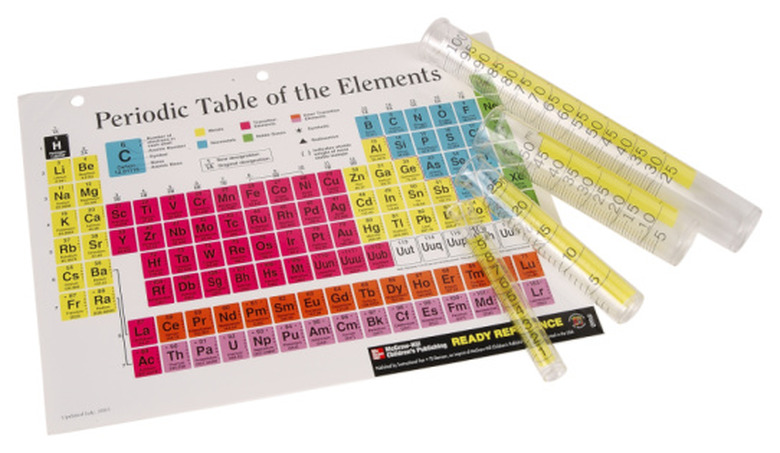How To Find The Number Of Moles Needed To React
Chemists routinely perform calculations of the amount of substances necessary to carry out a chemical reaction. Textbooks refer to this topic as "stoichiometry." Chemists base all stoichiometric calculations on moles. A mole represents 6.022 x 10^23 formula units of a substance, and this number corresponds to the number of formula units of substance necessary for the sample to exhibit a weight equal to its formula weight in grams. Formula weight, in turn, represents the sum of the atomic weights, as found on the periodic table of the elements, of all of the atoms in the formula. Table salt, also known as sodium chloride or NaCl, for example, exhibits a formula weight of 58.44, which means that 58.44 grams of sodium chloride would represent 1 mole, or 6.022 x 10^23 formula units of NaCl.
Step 1
Write down a balanced chemical equation for the reaction under investigation. A balanced reaction contains the same number of each type of atom on both sides of the reaction arrow. For example, the reaction between calcium hydroxide, or Ca(OH)2, and hydrochloric acid, or HCl, is represented by Ca(OH)2 + HCl → CaCl2 + H2O. This reaction is not balanced, however, because the left side contains two oxygen atoms and one chlorine atom, whereas the right side contains two chlorine atoms and one oxygen atom. The balanced form of this equation would be Ca(OH)2 + 2 HCl → CaCl2 + 2 H2O, which contains the same number of atoms on each side of the arrow.
Step 2
Calculate the formula weights of all of the compounds involved in the reaction. The formula weight, or molecular weight, represents the atomic weights, as found on the periodic table of the elements, of all of the atoms in a chemical formula. For example, CaCl2 contains one calcium and two chlorine atoms, which exhibit atomic weights of 40.08 and 35.45, respectively. The formula weight of CaCl2 is therefore (1 x 40.08) + (2 x 35.45) = 100.98.
Step 3
Calculate the number of moles for any compound in the balanced equation for which you know the mass. The masses of all other substances can be calculated from the mass of just one product or reactant. In the case of the balanced reaction Ca(OH)2 + 2 HCl → CaCl2 + 2 H2O, to calculate the moles of HCl required to react with 10 grams of calcium hydroxide, Ca(OH)2, the number of moles is given by dividing the mass of substance by the formula weight. In this case, the formula of weight of Ca(OH)2 is 74.10, and therefore 10 grams of Ca(OH)2 represents 10 / 74.10 = 0.13 moles.
Step 4
Determine the number of moles needed to react by multiplying by moles of the known substance by the stoichiometric ratio of the unknown substance to the known substance. For example, in Ca(OH)2 + 2 HCl → CaCl2 + 2 H2O, the stoichiometric ratio between HCl and Ca(OH)2 is 2:1 because the coefficients in front of the formulas in the balanced equation are 2 and 1, respectively. Continuing the example from the previous step, 0.13 moles of Ca(OH)2 corresponds to 0.13 x 2/1 = 0.26 moles of HCl. This represents the moles of HCl required to react with 10 grams of Ca(OH)2.
Things Needed
- Periodic table of the elements
- Scientific calculator
Cite This Article
MLA
Brubaker, Jack. "How To Find The Number Of Moles Needed To React" sciencing.com, https://www.sciencing.com/number-moles-needed-react-8386907/. 24 April 2017.
APA
Brubaker, Jack. (2017, April 24). How To Find The Number Of Moles Needed To React. sciencing.com. Retrieved from https://www.sciencing.com/number-moles-needed-react-8386907/
Chicago
Brubaker, Jack. How To Find The Number Of Moles Needed To React last modified August 30, 2022. https://www.sciencing.com/number-moles-needed-react-8386907/
